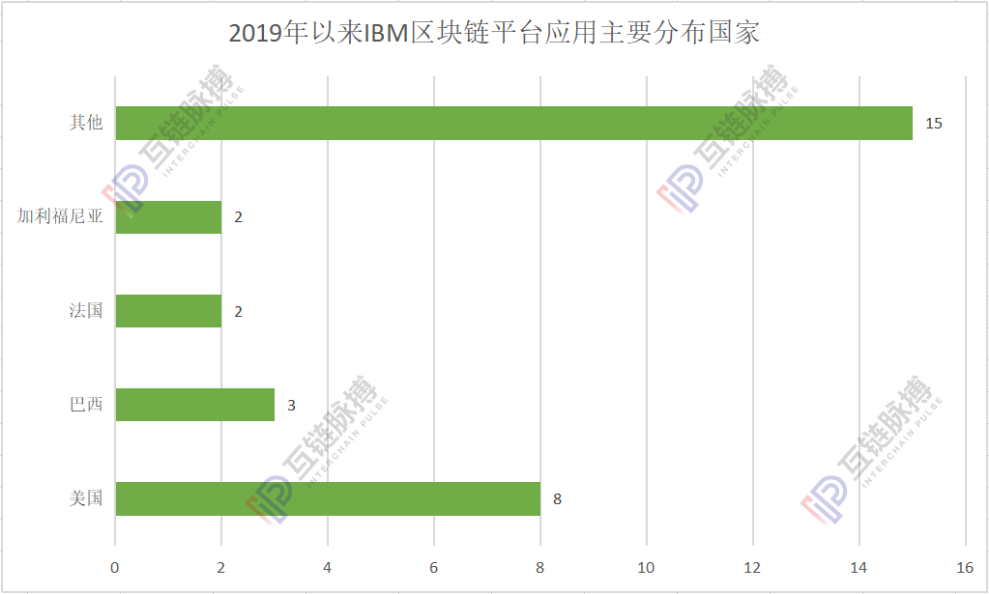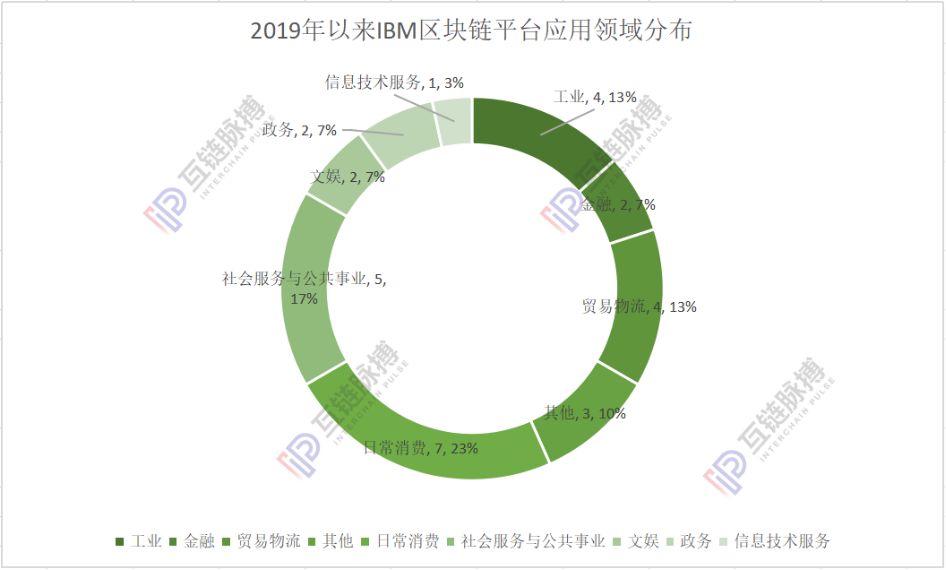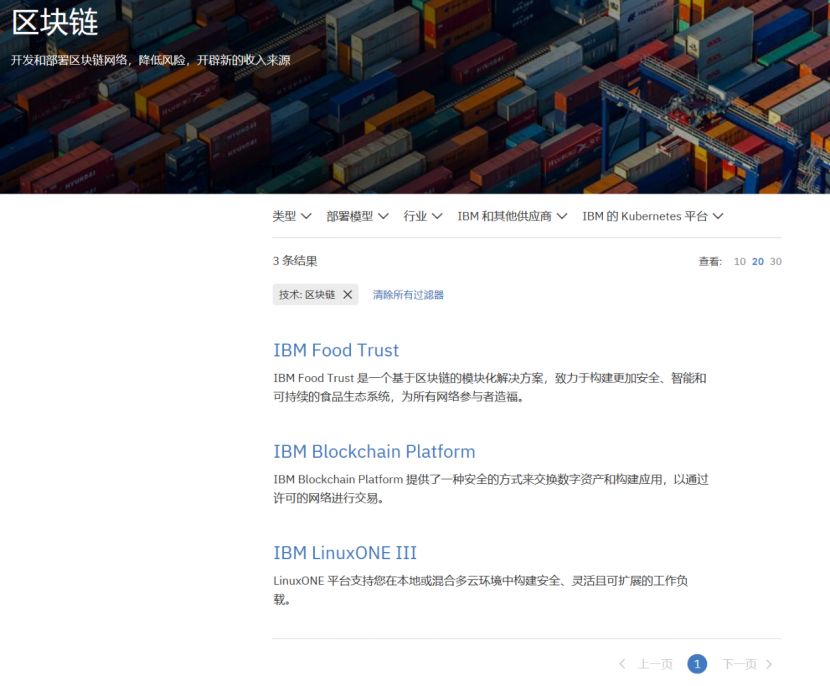In a year, 27 items of landing applications were disclosed. The IBM blockchain is only for nurturing cloud services?
Recently, IBM's blockchain business has been active.
On February 3, IBM said it was conducting feasibility tests with international food regulators. At the same time, IBM also introduced a distributed ledger solution for contract workers, which claims to automate many of the more burdensome payment processing tasks. The next day, IBM's most widely used Food Trust platform added another international partner, the French food company Avril Group, which has begun using IBM Food Trust to ensure product traceability.
According to incomplete statistics of the inter-chain pulse, IBM disclosed 27 landing projects in 2019, which is 3 more than the ant blockchain with the largest number of landings in China. At the same time, the recent remarks by Jerry Cuomo, vice president of IBM's blockchain technology, "Every $ 100 million invested in the blockchain will cost $ 15 in the cloud business."
Multi-party cooperation, obvious characteristics of IBM blockchain application platform
Since 2019, based on the blockchain technology provided by IBM, a total of 30 projects have been implemented, involving enterprises and related institutions in more than 20 countries. Among them, there are 8 projects that cooperate with American companies the most, followed by Brazil with 3 projects. In addition, IBM also cooperates with companies in France, California, Australia, Japan, Saudi Arabia, Germany and other countries.
- Vitalik: Uniswap v2 Price Predictor Can Withstand Lightning Loan Attacks
- Take Mentougou as an example: Do investors in FCoin have a future?
- Coin price soared, 51% attack, "destruction" and "reputation" on the way of reducing Bitcoin Cash (BCH) production

(Drawing: Interchain Pulse)
From the scope of application, IBM focuses on the two major areas of daily consumption and trade logistics. Among the 30 items of inter-chain pulse statistics. There are 7 projects in the field of daily consumption, accounting for 23%; 5 projects in the field of social services and public utilities, which are mainly used in the medical industry; 4 projects each in the field of trade logistics, industry, accounting for 26%.

(Drawing: Interchain Pulse)
IBM's blockchain applications are mostly developed in the form of industry industrial chains. At present, more projects are disclosed by Food Trust, a food traceability platform, TradeLens, a logistics platform, and Blockchain World Wire, a payment system. These three platforms are all built with giants in the industry and industry.
In the first quarter of 2017, Wal-Mart began to explore block applications, using the hyperledger blockchain system for food supply chain management. Starting in the second quarter of 2017, the platform was jointly evaluated by IBM and Tsinghua University. On October 9, 2018, IBM announced that the Food Trust platform was officially commercialized after 18 months of testing. At that time, Food Trust had 49 members and more than 15,000 stores.
Since 2019, IBM has announced a total of seven new projects using the Food Trust platform, involving companies in five countries including France, the United States, Tunisia, the Netherlands, and Brazil. These projects cover the food traceability of some large commercial supermarkets, as well as specific food supply chain applications.

(Drawing: Interchain Pulse)
On April 15, 2019, Nestlé, Carrefour and IBM will use IBM blockchain technology to track the supply chain of French mashed potato brand Mousline. Consumers can scan the QR code with their smartphones to understand the source of mashed potato and the entire supply Chain of information. In January news, CHO, one of the largest olive oil producers in the southern Mediterranean, announced that it is using IBM's blockchain technology to trace the production of its extra virgin olive oil from Terra Delyssa. In addition, recent projects launched on the Food Trust platform include traceability of seafood products, mashed potato supply chain management, and more.
Not long after Food Trust went online, in January 2018, IBM announced that it and Maersk jointly developed a blockchain global supply chain application platform-TradeLens. In the early days of the platform, 94 organizations were already involved.
The TradeLens platform is mostly used for terminals and customs in various countries. Five of the six major ocean transport companies including Maersk, Hapag-Lloyd, Marine Network Express, MSC and CMA-CGM have already used TradeLens.
Since 2019, the TradeLens platform has revealed specific projects in three countries. On May 22, 2019, Saudi Arabia's customs department has passed the first trial of TradeLens to transport goods from Saudi ports to Belgium. On December 19, 2019, the Geme International Terminal in Ho Chi Minh City, Vietnam announced that it has joined IBM TradeLens. On January 2, 2019, the Jordanian Customs Department announced the trial of the TradeLens blockchain supply chain platform project.
In terms of supply chain management, on August 5, 2019, IBM announced that it will also launch a new network called "Trust Your Supplier" aimed at improving manual and tedious supply chain management.

(Drawing: Interchain Pulse)
Following Food Trust and TradeLens, Blockchain World Wire, a payment system supported by IBM's DLT, is officially launched, targeting inter-bank international settlement services. The co-builder this time is Stellar, a cross-border payment and clearing platform.
Unlike most existing cross-border settlement platforms, Blockchain World Wire can use IBM and financial service provider Stronghold to jointly launch Stronghold USD settlement, which is linked to the US dollar. IBM has great expectations for this decision and platform.
Jesse Lund, head of the IBM blockchain division, is optimistic about the use of stablecoins: "Volatility and inherent risks mean that most financial institutions are cautious about using cryptocurrencies for mainstream business transactions, and some countries even ban them completely … However, the stability of the stablecoin can be used as the main force to improve the operation of the entire international bank, provide innovative means for banks to significantly update their core banking and compliance infrastructure, and also help improve operational efficiency and regulatory transparency. In addition, IBM also claims Blockchain World Wire will participate in approximately 60% of the world's trading systems, and its size is expected to reach the top of the $ 2 trillion industry by 2020.
The blockchain business emerging from the Internet of Things project has already spawned cloud projects
In a public speech in March 2018, Marie Wieck, general manager of IBM's blockchain business, said that IBM had started blockchain research as early as 2014.
At that time, IBM's blockchain research was attached to its IoT business. IBM has cooperated with Samsung in 2014 to jointly develop IoT projects. The ADEPT project, a decentralized P2P automatic telemetry technology jointly developed by the two, was successfully applied to the re-ordering of detergents and repair parts for Samsung washing machines, as well as the calibration of self-consumed electricity. This project has identified three key points of the IoT decentralized system: P2P messaging, decentralized file sharing, and automatic device coordination.
At the same time, the Internet of Things project also gives IBM a certain accumulation of blockchain technology and project experience. In 2015, the news of IBM developing its own blockchain payment system was confirmed. Arvind Krishna, senior vice president of IBM Research, also expressed optimism about the development prospects of blockchain: "Blockchain technology is very interesting. I hope to expand banking services to 3.2 billion and serve the middle class in the next 15 years. So I need A cheaper way to store ledgers, the blockchain just provides interesting possibilities. "
In April 2015, IBM launched the blockchain platform IBM Blockchain. After that, relying on Hyperledger Fabric, IBM Blockchain achieved normal operations. As the main participant, IBM co-built the Hyperledger project under the Linux Foundation. In 2017, the first production blockchain code Fabric 1.0 was released. Until now, many of IBM's partners disclosed that they used the IBM Hyperledger platform.
The four projects disclosed in 2019 clearly indicate that they are based on blockchain technology provided by IBM and built using Hyperledger Fabric. As reported on June 4, 2019, the National Cancer Institute will use the IBM Hyperledger blockchain to share clinical data among healthcare providers, patients, and the research community.

(Drawing: Interchain Pulse)
However, blockchain industry applications are only part of the IBM blockchain business.
Information on the IBM official website shows that IBM mainly provides three blockchain platforms / product services: IBM Food Trust, IBM Blockchain Platform, and IBM LinnuxONE Ⅲ. IBM Food Trust is a blockchain modular solution.

In addition, IBM is also involved in the blockchain hardware business. IBM LinnuxONE III supports building secure, flexible, and scalable workloads in local or mixed multi-cloud environments. IBM's blockchain hardware business originated in 2017. In July 2017, IBM launched a blockchain-powered host server, IBM Z, which is said to be able to process more than 12 billion crypto-based encryptions through strong data encryption technology Cloud or database transactions, and in terms of data encryption, the server's processing speed was 18 times the speed of traditional platforms at the time.
It is worth noting that IBM's blockchain hardware and cloud business are closely integrated. Now, the main functions of IBM LinnuxONE III include protecting data and hybrid cloud platforms, flexible building in hybrid clouds, and helping to deploy cloud-native application development support.

In fact, in order to develop blockchain technology, IBM has invested heavily in cloud computing.
According to a foreign media report on February 10, Jerry Cuomo, vice president of IBM blockchain technology, said that for every $ 100 million invested in the blockchain, $ 15 is invested in the cloud business.
Cuomo said that blockchain is a new type of enterprise application that participates in application modernization, cloud-native applications, data analysis, and more. But in a blockchain solution, the part that uses blockchain technology only accounts for about 20% of the overall solution, and the remaining 80% is composed of other technologies.
The blockchain integrates a variety of information technologies, and the common output of industry solutions has almost become the industry consensus. As a veteran information technology and business solutions company, IBM has already developed multiple businesses such as cloud computing, artificial intelligence, and IT services. These information technology businesses are often integrated and developed together.
In 2018, IBM acquired open source software giant Red Hat for $ 34 billion. In the fourth quarter of 2019, IBM announced its revenue growth: cloud and cognitive software revenue increased 9%, while Red Hat revenue increased 24%.
October 11, 2019 news, a new supply chain service launched by IBM is based on its blockchain platform and Red Hat's open source software. The service integrates technologies such as blockchain and artificial intelligence to support real-time viewing of order shipments, alerts, and optimization recommendations. Using open APIs, this supply chain suite allows distributors, manufacturers, and retailers to integrate themselves and their suppliers' data and networks onto the blockchain to track products and components. Data that can be integrated include IoT sensor systems for real-time cargo location positioning.
It's not just IBM that uses cloud computing in blockchain solutions.
Tencent's blockchain BaaS platform is based on cloud business-Tencent Cloud Blockchain TBaaS platform. On January 9th, Tencent Cloud released the world's first building material traceability blockchain platform, Tencent Cloud Weiwei concrete quality blockchain platform. It is understood that the platform relies on construction to support the rapid construction of blockchain services in a flexible, open cloud platform and privatized environment, simplifying the construction and operation of blockchain. After that, Tencent Cloud will also assist Shenzhen Baoan District government departments to promote the integration of big data, cloud computing, blockchain and building consumable concrete quality supervision services. Similarly, the ant blockchain BaaS is an open "blockchain as a service" platform based on the ant financial services alliance chain and Alibaba Cloud, which outputs the blockchain as a cloud service.
We will continue to update Blocking; if you have any questions or suggestions, please contact us!
Was this article helpful?
93 out of 132 found this helpful
Related articles
- Don't blame "Lightning Loan", bZx is attacked by it
- Five countries are strengthening cryptocurrency regulation
- Why is Meme essential to the success of cryptocurrencies?
- Read the Byzantine General
- Technical Primer | Explore the key details of BFT and Libra's Consensus components
- Crypto Custody Company Copper Completes Series A Financing, MMC Ventures, LocalGlobe Participate
- Blockchain helps public welfare charity research report: feasibility analysis, application scenarios, challenges and prospects





